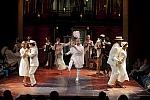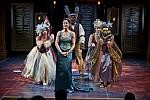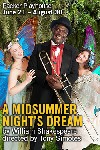A Midsummer Night's Dream
A Signature Magical Piece for Shakespeare & Company
By: Maria Reveley - Aug 11, 2014
A Midsummer Night’s Dream
By William Shakespeare
Directed by Tony Simotes, Artistic Director
Set Designer, Travis George; Costume Designer, Deborah A. Brothers; Lighting Designer, Matthew E. Adelson; Composer/Sound Designer/Music Director, Alexander Sovronsky; Movement Director, Barbara Allen; Stage Manager, Diane HealyCast: Johnny Lee Davenport (Bottom/Pyramus), Jonathan Epstein (Quince), Kelly Galvin (Hermia/Fairy), Cloteal L. Horne (Helena/Fairy), Malcolm Ingram (Starveling/Moonshine), Merritt Janson (Hippolyta/Titania), David Joseph (Lysander), Colby Lewis (Demetrius), Robert Lohbauer (Snout/Wall), Briana Maia (Peaseblossom/Manager of Mirth), Annette Miller (Mustardseed/Manager of Mirth), Rocco Sisto (Theseus/Oberon), Alexander Sovronsky (Flute/Thisbe), Michael F. Toomey (Puck/Master of Ceremonies).
Tina Packer Playhouse
Shakespeare & Company
Lenox, Massachusetts
June 21 – August 30, 2014
It’s no wonder A Midsummer Night’s Dream is considered by some to be the signature piece at Shakespeare & Company. It started the first season off in 1978 at The Mount (the magnificent home of Edith Wharton) and Tony Simotes, who is currently the Artistic Director of Shakespeare & Company and the director of this production, played Puck.
And, it marked the Company’s last performance in 2000 before moving to this new, improved venue with the Tina Packer Playhouse.
To mark Shakespeare’s 450th birthday, Simotes has chosen to bring back this magical play and set it in the Jazz Era (early 1930s) in New Orleans. Why New Orleans, you may ask? Because New Orleans has a history of magic, called Voudou (Voodoo), that dates back to the 1800s, with the arrival of African and Haitian immigrants. This ‘religion’ believes in two worlds, the seen world around us and the unseen world of the spirits, and includes the use of herbs and spices to allow a person to better serve the spirits.
A Midsummer Night’s Dream, with its mechanicals (based on the workmen of Shakespeare’s time), fairies (based on English folklore), and Hippolyta and Theseus (characters from Greek legend), brings these seen and unseen worlds together to create magic in the woods.
Choosing New Orleans in the Jazz Age provides a fitting and magical setting for this brew of characters. And the flower, Love-in-Idleness, resembles the herbs of Voudou, by placing it on the humans to serve the spirits.
The mystery of the New Orleans music, the Spanish Moss tree, the mischief Puck renders all entwine to help the young lovers get together. As the characters get lost in the woods, they lose their inhibitions, change identities, and become ultimately transformed, in what they think is a dream. This is an every day occurrence during Mardi Gras in New Orleans!
The acting throughout this humorous play is lively and very physical, with kudos going to Simotes, the Fight Choreographer and his team, for staging such graceful and exciting scenes. We particularly enjoyed the performances of the four lovers – Kelly Galvin as Hermia, Cloteal L. Horne as Helena, David Joseph as Lysander and Colby Lewis as Demetrius. They were all engaging and immersed the audience in their plights.
Also engaging and stealing the show was Johnny Lee Davenport as Bottom/Pyramus. He was superb in the mechanicals, making the best suggestions, and as transformed into an ass, provided great laughs.
My only quibble was the length of the production (two and a half hours plus intermission), which could have been trimmed.
We saw this play on the night of the Super Moon, where the brightness was greater by thirty percent because of the Moon’s closeness to Earth. As we left the Tina Packer Playhouse gazing at this magical moon, I couldn’t think of a more perfect ending to such a magical production.






